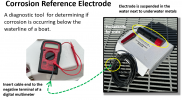Jeff58
Well-known member
- Joined
- Aug 23, 2016
- Messages
- 69
- Fluid Motion Model
- C-24 C
- Non-Fluid Motion Model
- Cutwater 28
- Vessel Name
- Chiasso
I have a R29 S 2024 model year tug. My marina tests for stray current around vessels at the dock. They detected current at the aft of our boat around the swim platform (port, starboard, middle) and nowhere else. They use a floating sensor that beeps and flashes a red light when current is present... not an overly sophisticated device. When unplugged from shore power the problem is eliminated. I am in fresh water and only run the battery charger and refrigerators at the dock. I have not noticed any unusual anode issues although the boat is only on the second season. I moved the boat to the transient side of the marina, which has a new electrical drop and shore posts and the problem continues.
The marina in general is old and was built on a previous rail yard so the only "earth" is the top few inches otherwise it is railroad ballast (rock). Not sure this is relevant, but makes me wonder about the grounding side of the grid.
Is there a switch, other than the main shore power breaker on the panel to shutdown the Kiase battery charger that I am missing?
I am very interested in guidance on where and how to start in diagnosing and correcting.
Thanks,
Jeff.
The marina in general is old and was built on a previous rail yard so the only "earth" is the top few inches otherwise it is railroad ballast (rock). Not sure this is relevant, but makes me wonder about the grounding side of the grid.
Is there a switch, other than the main shore power breaker on the panel to shutdown the Kiase battery charger that I am missing?
I am very interested in guidance on where and how to start in diagnosing and correcting.
Thanks,
Jeff.

